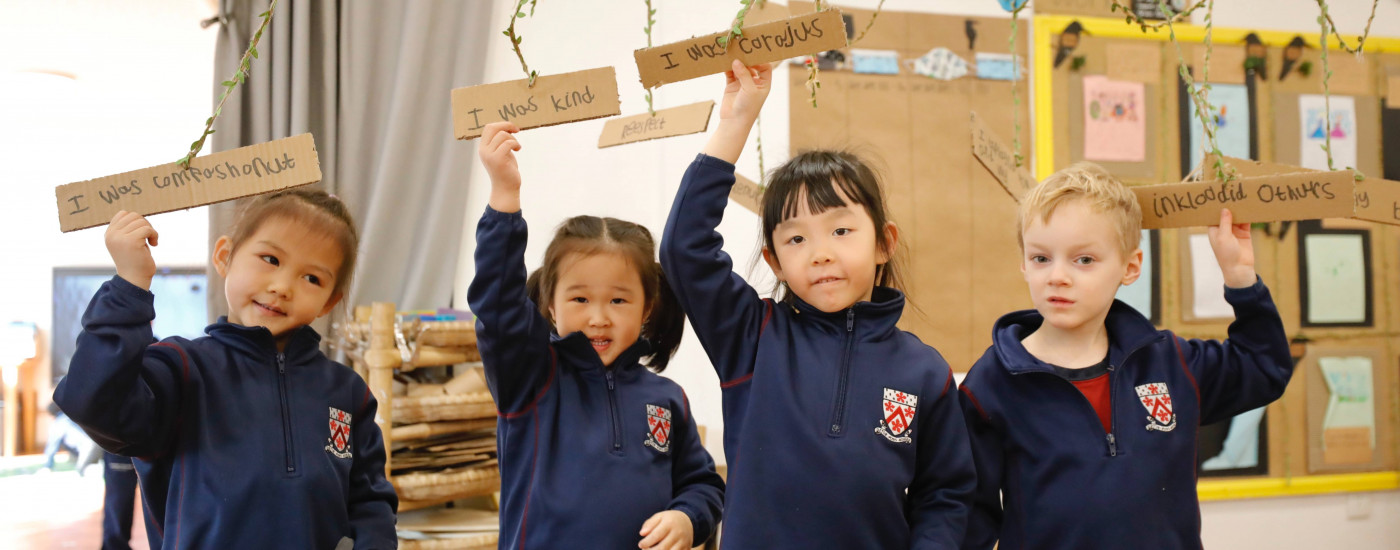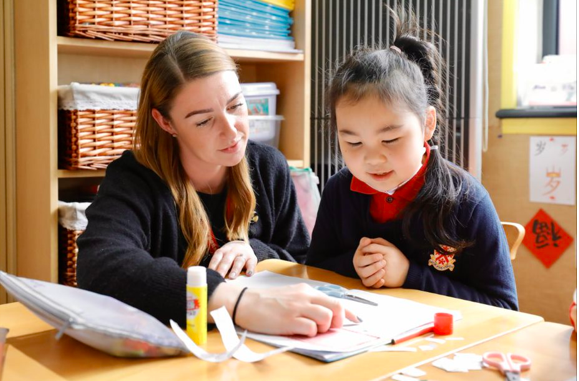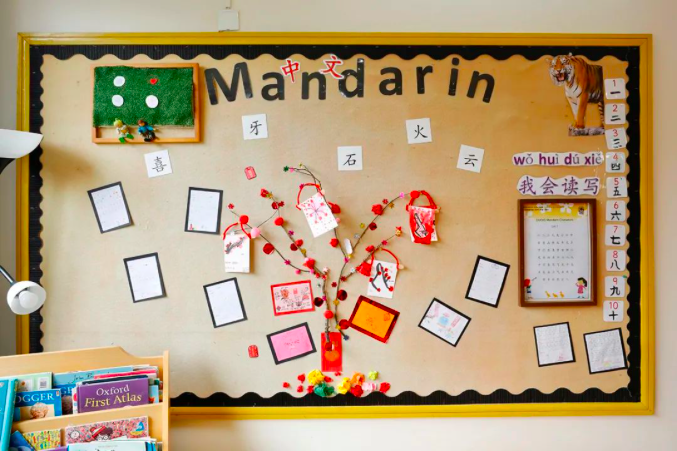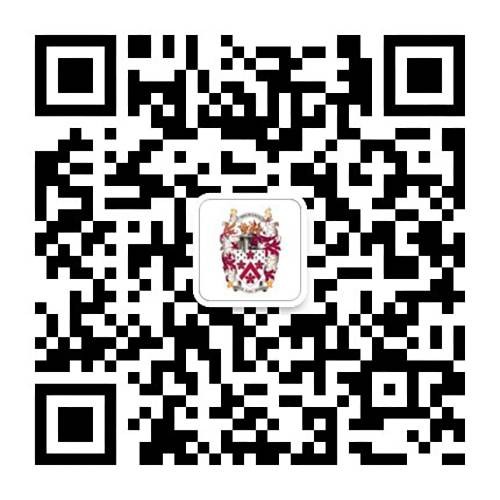Laying the Foundation of Bilingual Fluency in DUCKS

At DUCKS we aim to set up children for life-long language success. We value both English and Mandarin equally and our unique Dual Language teaching approach ensures that children acquire both languages concurrently.
Our Dual Language approach begins in Toddlers and runs all the way through Year 2. The aim is to develop fluent speakers in English and Mandarin by the end of Year 2 who can comfortably switch from one language to another, while always remaining secure in their first language.
Children who graduate from DUCKS achieve a level of proficiency communicating in English and Mandarin in all social and learning contexts, setting them up for academic and life-long success.
The Bilingual Superpower

Studies clearly show that being bilingual has a positive effect on a child’s cognitive development. People who can speak two or more languages have higher levels of cognitive brain function, and are more adept at solving problems, planning, and other higher-order thinking, or “mentally demanding tasks”.
Bilingual people are often forced to shift between languages on the fly, providing them with something like a high-intensity workout for the brain, which makes them quicker and better at multi-tasking.
Research based approach

Our Dual Language pedagogy is based on extensive research. In line with Krashen’s notion of “input hypothesis”, children are exposed to “comprehensible input”, or language that is just beyond a learner’s current competence, in meaningful contexts.
The model is also informed by Vygotsky’s Socio-Cultural Theory in which young children’s language acquisition arises from the process of making meaning in collaborative activities with other speakers of the language.
DUCKS Dual Language Coordinator Amy Gilvary sums it up, “Our approach is based on the knowledge that learning takes place as children interact with people and their environment and the learning is mediated through language provided by the adults in the environment.”

Dual Language at DUCKS
Our Dual Language model is based on the two main principles:
- Wherever possible, a child’s conceptual development is facilitated by use of their first language.
- While the main language of instruction in Year 1 and Year 2 is English, learning is supported through team teaching using both languages in authentic contexts.

In Early Years, students are taught by two adults, one lead who speaks primarily English and one who speaks primarily Mandarin. In addition, entries into a child’s online Tapestry journal will often comment on their use of language.
In KS1 (Year 1 and Year 2), day to day interactions and conversations help to encourage and informally monitor language development in both English and Mandarin. Each week, during discreet English and Mandarin lessons, there are formal opportunities to encourage and extend language development.
Underpinning this is a Positive Relationships framework. In order for all children to learn and reach their full potential, the relationships children establish with all the adults in their environments and the working relationships between adults in the settings is extremely important to the success of our Dual Language Approach.

Two important tools facilitate Dual Language learning in DUCKS:
- Individual Dual Language Profile (IDLP)
The IDLP is a highly structured document personalised to each child and available to the child’s teachers. It grows and evolves along with the student as a chronicle of challenges and success providing a real-time view of the child’s current situation.
- Language Development Continuum (LDC)
The LDC is a map of the six developmental phases of language proficiency in Speaking and Listening from being ‘new’ to being competent in the receptive and expressive use of the language. These levels are common across DUCKS and are used to monitor a child’s development of English and Mandarin.
The Results

Our Dual Language Programme lays the foundation for fluency in both English and Mandarin. The aim is that by the time children move from DUCKS to the Junior School they will have achieved Basic Interpersonal Communication Skills (BICS) as well as Academic Language Proficiency (CALP), enabling them to be confident in their use of both languages and be fully prepared to access more advance parts of the curriculum in Junior School.
How can you help your child at home?

We often hear this question asked by parents and there are many ways for that to happen.
First and foremost, use your home language at home. The more competency and confidence a child develops in their home language, the easier it will be for them to develop a similar level of competency in an acquired language.
Children who are secure in their conceptual understanding in their home language can transfer this concept to the learning contexts in an additional language. It is vital for children’s cognitive development that they continue to develop in their home language.
Some parents might assume that by switching to using the language of school in the home, their child will acquire the language more quickly. Research shows that this is not recommended. On the contrary, speaking and reading to children in their home language is the best way parents can support their child’s overall language and cognitive development.
Here are some suggested ways to support the development of the home language:
- Talk to your child in your home language about their day at school. What did they do? Who did they play with?
- For Early Years children, use the class blog and Tapestry journals to find out what your child has been learning about at school. Talk to them about the blog and their Tapestry observations. Find related books to read to your child in your home language or related toys or other items to play with your child using your home language.
- Books written in English do not always have to be read in English! You can "share" books written in one language with your child using your home language. Become a storyteller and tell them the story or just talk about the pictures!
- As much as possible, provide stimulating, enjoyable and interesting experiences for your child to do together such as trips to places of interest, cooking, art and crafts, outdoor activities and watching movies. These rich experiences provide valuable opportunities for children’s cognitive and home language development.
- Understand there is a silent phase which will vary for each child and don’t become anxious about how long it takes until your child is ready to speak in the new language.
- Don't pressure your child to speak the language if they are not confident to do so.
- Be a good language role model by learning some of the additional language yourself and using it in interactions with speakers of the language.
- Be friendly towards speakers of the additional language. Never make negative generalised comments about speakers of the language in front of your child.
- Don’t correct your child’s use of language. Instead, model the accurate use in a natural way. For example if your child says, “Today I play with my friend Sally and Sue.” Respond by saying, “You played with Sally and Sue? They are nice friends.”
Taken together these simple strategies can propel your child to acquire additional languages faster and with a deeper level of fluency.










